
U of S researchers partner with First Nations community to measure climate change
SASKATOON – University of Saskatchewan (U of S) researchers are working with the Okanese First Nation in southern Saskatchewan on a project to track and adapt to the effects of climate change on reserve lands.
Earlier this month, a climate monitoring station was installed on Okanese land: the first of four automated stations that will record and share data on the local temperature, rainfall, humidity, air pressure and wind.
The stations are part of a project called Kikawinaw Askiy: Reconciling with Indigenous Sacred Ecology. Undertaken in partnership with the U of S, the initiative is supported by $125,000 in funding over three years from Crown-Indigenous Relations and Northern Affairs Canada (CIRNAC).
“When we were approached by Okanese to be a part of this project, we jumped at the chance,” said Bob Patrick, a faculty member in the geography and planning department of the College of Arts and Science. “Blending western and Indigenous land-based knowledge to address pressing issues like climate change and water protection is a win-win for everyone.”
The goal of the project is to help restore the local ecological balance as well as the community’s relationship with the land. That relationship has been damaged by residential schools and other government policies, said Okanese First Nation Chief Marie-Anne Daywalker-Pelletier.
Grass fires fueled by drought and threats to the community’s drinking water supply are among the concerns that motivated the project.
“Climate change threatens Kikawinaw Askiy(Mother Earth)—our lands, water, plants and, ultimately, our livelihood—all that gives us life. As First Nations, we have a duty to protect the land,” said Chief Daywalker-Pelletier.
Patrick and fellow Department of Geography and Planning faculty member Krys Chutko are co-leaders of the U of S side of the partnership. On Oct. 6, they delivered the climate stations to Okanese First Nation, where Chutko trained community members on how to install and maintain the stations.
Data from the stations will be used in two related projects funded by CIRNAC at the Okanese First Nation: a climate change adaptation plan and a drinking water protection plan.
During the coming weeks, Patrick will facilitate meetings at Okanese in which leaders, Elders and members of the community will identify risks posed by climate change and develop an action plan. The community’s drinking water system will also be assessed and a protection plan developed.
It is important that the planning process draws on both western scientific knowledge and Indigenous knowledge, said Patrick. “We’ll be listening to what the instruments are saying and what the Elders are saying, and seeing how one can corroborate the other.”
The youth of the Okanese First Nation will also participate in the projects by learning climate science and creating artwork and posters in school classrooms.
The Okanese First Nation is located in the Lower Qu'Appelle River Watershed, about 100 km northeast of Regina.
–30–
For more information, contact:
Chris PutnamCommunications Officer
University of Saskatchewan
306-966-1982
chris.putnam@usask.ca

